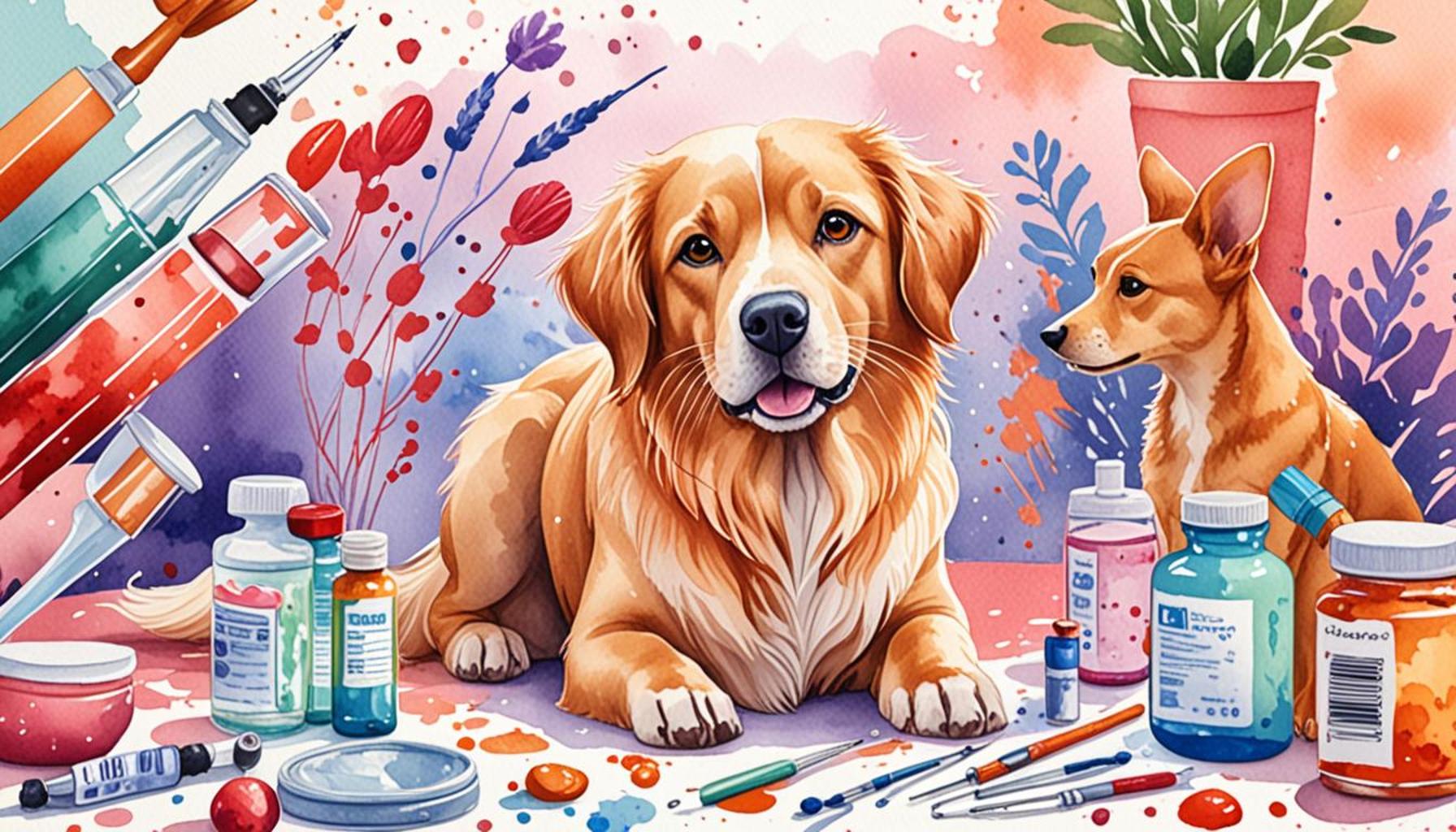Tips for Maintaining the Skin and Coat Health of Pets

The Importance of Proactive Care for Your Pet’s Skin and Coat
The skin and coat of a pet are not just superficial aspects of their appearance; they play a crucial role in their overall health. When a pet’s skin is healthy, it acts as a barrier against bacteria, allergens, and environmental factors, while a shiny coat reflects good nutrition and proper grooming. Fortunately, pet owners can take several proactive measures to maintain skin and coat health, ensuring their furry friends are comfortable and looking their best.
Regular Grooming: A Bonding Experience
Regular grooming is perhaps one of the most direct ways to ensure your pet’s skin and coat remain healthy. Grooming not only removes dirt, debris, and loose fur but also redistributes natural oils produced by the skin. For instance, long-haired breeds like Golden Retrievers or Persians may require daily brushing, while short-haired breeds such as Beagles might only need weekly brushing. This engagement not only helps maintain coat integrity but also strengthens the bond between pet and owner, making grooming a delightful experience.
Balanced Diet: Feeding for Health
A balanced diet plays a significant role in skin and coat health. Foods rich in omega-3 and omega-6 fatty acids—found in ingredients like fish and flaxseed—promote healthy skin and a shiny coat. High-quality commercial pet foods are formulated with these nutrients, but pet owners might also consider supplementing their pets’ diet with fish oil or specific vitamins under veterinary advice. For example, a diet lacking essential fatty acids can result in dry, flaky skin and a dull coat, which could easily be remedied by dietary adjustments.
Understanding Bathing Needs
Establishing a suitable bathing schedule is essential for maintaining a pet’s skin health. While frequent baths can lead to a stripped coat and dry skin, infrequent bathing can allow oil buildup and odor. Pet owners should generally aim to bathe their pets every 4 to 6 weeks, adjusting for specific needs depending on activity level and coat type. For example, a dog that spends a lot of time outdoors may need more frequent baths compared to an indoor cat. Utilizing gentle, pet-specific shampoos can further protect the natural oils that help keep skin moisturized.
Hydration: The Foundation of Health
Hydration is critical for maintaining skin elasticity and overall health. Ensuring that pets have access to fresh and clean water throughout the day can significantly contribute to keeping their skin well-moisturized. Dehydration can lead to dryness and increased susceptibility to skin issues. Incorporating wet food into their diet can also be beneficial, especially for cats who may not drink sufficient water.

Veterinary Checks: Prevention is Key
Lastly, regular veterinary checks should be prioritized to ensure early detection of any underlying skin conditions. Skin problems in pets can manifest as itching, redness, or unusual odors, indicating potential allergies, infections, or even parasites. A veterinarian can provide tailored advice on skin care routines, treatments, or specialty diets, ultimately helping pet owners identify and respond to any issues before they escalate.
By adopting these strategies, pet owners can contribute significantly to the skin and coat health of their companions. Not only will their pets look better, but they’ll also feel better, leading to a happier and healthier life. Regular maintenance paves the way for long-lasting well-being, ensuring that pets remain cherished members of the family for years to come.
DISCOVER MORE: Click here to learn about the benefits of socialization training
Essential Practices for Optimal Skin and Coat Care
While grooming and diet are paramount in maintaining the health of a pet’s skin and coat, several additional practices play an equally significant role in fostering overall well-being. By combining these elements, pet owners can create a comprehensive routine that enhances both aesthetics and health.
Environmental Considerations: Creating a Safe Space
The environment in which pets live can have a profound impact on their skin and coat health. Exposure to allergens such as pollen, dust mites, and mold can trigger skin irritations or exacerbate existing conditions. To minimize these risks, pet owners should consider the following:
- Regular Cleaning: Frequent vacuuming and dusting can reduce allergens in the home.
- Pet-Safe Products: Opt for non-toxic cleaning supplies and air fresheners, as chemicals can irritate pets’ skin.
- Humidity Control: Maintaining a balanced humidity level can prevent dry skin. Consider using a humidifier, especially during dry winter months.
Sun Protection: Shielding Your Pet from Harmful Rays
Just like humans, pets are susceptible to sun damage, particularly those with light-colored fur or exposed skin. Prolonged sun exposure can lead to conditions like sunburn or even skin cancer. Pet owners can protect their furry friends by:
- Limiting Sun Exposure: Scheduling outdoor playtime during cooler parts of the day, such as early morning or late afternoon.
- Using Sunscreen: Specialized pet-safe sunscreens available at pet stores can be applied to sensitive areas such as the nose and ears.
- Providing Shade: When outdoors, ensure that pets have access to shaded areas where they can escape direct sunlight.
Flea and Tick Prevention: A Year-Round Commitment
Fleas and ticks not only cause discomfort and itching but can also lead to more serious health problems in pets. Prevention is essential to keep these pests at bay. Consider the following:
- Year-Round Treatment: Administer preventative medications consistently, even in colder months, as some pests can survive in homes.
- Regular Inspections: Check your pet for fleas and ticks after outdoor activities, especially in wooded or grassy areas.
- Environmental Treatment: Use flea and tick treatments in your home, including sprays and foggers, to eliminate any residing pests.
Incorporating these essential practices not only supports the health of your pet’s skin and coat but also enhances their overall quality of life. Pet owners can make informed choices by staying proactive, ensuring their companions feel their best all year long. This commitment to care can lead to happier pets, strengthening the bond between them and their owners as they thrive in a healthy environment.
Essential Tips for Maintaining Your Pet’s Skin and Coat Health
As a pet owner, it’s vital to ensure the well-being of your furry companion, particularly their skin and coat health. Several factors contribute to the overall condition of their skin and coat, including diet, grooming habits, and environmental influences. Implementing effective strategies can significantly enhance your pet’s comfort and appearance. Here are some tips worth considering:
| Category | Benefits |
|---|---|
| Proper Nutrition | A balanced diet rich in omega fatty acids promotes healthy skin and a shiny coat. |
| Regular Grooming | Frequent brushing removes dirt and loose hair, while also distributing natural oils. |
Beginning with your pet’s diet, a high-quality food that contains essential nutritional elements, such as vitamins E and A, can bolster your pet’s skin barrier. Foods enriched with fatty acids, for example, enhance moisture retention and mitigate dryness, significantly improving coat quality. Equally important is maintaining a routine grooming schedule. Regular brushing not only keeps shedding under control but also stimulates blood circulation, fostering healthier skin and coat growth.
Along with these practices, it’s crucial to monitor environmental factors that can impact skin health. Allergens, pollutants, and extreme weather conditions all contribute to skin irritations. Ensure your pet’s environment is clean and comfortable, and consult with a veterinarian if you notice any skin issues, such as redness or excessive scratching. Remember, each pet is unique, and tailored care based on their specific needs can yield the best results.
DON’T MISS: Click here to learn how to keep your pets safe and healthy at home!
Advanced Care Techniques for Skin and Coat Health
In addition to basic care routines, there are several advanced techniques that can further bolster the health of your pet’s skin and coat. These methods often require collaboration with professionals but can yield significant benefits when integrated into your pet care regimen. Understanding these options allows pet owners to tailor their approach to their pet’s unique needs.
Regular Veterinary Check-Ups: Proactive Health Monitoring
One of the most effective ways to maintain your pet’s skin and coat health is through regular veterinary check-ups. These visits enable veterinarians to identify early signs of skin issues such as allergies, infections, or hormonal imbalances. Pet owners should be particularly vigilant about:
- Annual Wellness Exams: These comprehensive exams can reveal underlying health issues that might affect skin health.
- Allergy Testing: If you notice excessive scratching or licking, your vet can perform tests to pinpoint specific allergens.
- Dermatological Consultations: For persistent skin problems, a referral to a veterinary dermatologist can provide targeted treatment options.
Natural Supplements: Enhancing Skin and Coat from the Inside Out
Another strategy for boosting skin and coat health is the incorporation of natural supplements into your pet’s diet. Omega-3 and Omega-6 fatty acids are particularly noteworthy for their anti-inflammatory properties and their ability to promote a lustrous coat. Pet owners may consider:
- Fish Oil: Rich in Omega-3s, fish oil supplements can improve skin hydration and reduce itching.
- Flaxseed Oil: A plant-based Omega-3 source, flaxseed oil may also benefit skin health and coat gloss.
- Biotin and Zinc: Both essential for skin and coat health, these supplements can support cell regeneration and overall skin appearance.
Tailored Grooming Techniques: Beyond Basic Grooming
While regular brushing and baths form the foundation of grooming, there are advanced grooming techniques that can enhance your pet’s skin and coat health. These include:
- Professional Grooming: For certain breeds, periodic visits to a professional groomer can provide specialized care, including de-shedding and hand-stripping techniques that help maintain coat texture.
- Hydration Treatments: Specialty grooming spas often offer hydration treatments that can moisturize dry skin and enhance coat shine.
- Coat-Specific Products: Use shampoos and conditioners formulated for your pet’s coat type—such as moisturizing formulas for dry skin or deep cleaning options for oily coats—can make a notable difference.
Behavioral Indicators: Listening to Your Pet
Understanding your pet’s behavior can also provide valuable insight into their skin and coat health. Pay attention to the following behavioral indicators:
- Itching or Scratching: Excessive grooming or scratching can signal an underlying skin issue.
- Red or Inflamed Skin: These symptoms may indicate allergies or infections and warrant attention.
- Changes in Coat Texture: As a pet ages or if they’re under stress, changes in their coat’s texture can occur, necessitating a review of their diet and grooming routine.
By embracing these advanced care techniques, pet owners can significantly enhance their pets’ skin and coat health, leading to happier and more comfortable companions. This proactive approach not only fosters a beautiful appearance but also ensures the long-term health of your cherished pet.
DISCOVER MORE: Click here to learn how agility training benefits your pet
Conclusion: Ensuring Optimal Skin and Coat Health for Your Pets
In summary, maintaining your pet’s skin and coat health is a multifaceted endeavor that requires consistent effort, attention, and understanding of your pet’s unique needs. From regular veterinary check-ups to identify potential health issues, to incorporating natural supplements such as fish oil and flaxseed oil, every little detail contributes to a thriving coat and healthy skin. Furthermore, utilizing tailored grooming techniques can elevate your pet’s appearance and comfort, ensuring that they not only look great but feel great too.
Listening to your pet’s behavioral cues is crucial. An attentive pet owner can catch problems early, reducing the likelihood of discomfort and serious health complications down the line. In the end, prioritizing your pet’s skin and coat health is about more than just aesthetics; it’s a vital part of their overall well-being. By adopting these tips and techniques, you not only enhance their quality of life but also reinforce the special bond you share.
As you dig deeper into optimal pet care, consider reaching out to a veterinary professional or an experienced groomer. They can offer tailored advice suited to your pet’s specific needs and lifestyle. Remember, a little knowledge and proactive care can go a long way in fostering a vibrant, healthy, and happy companion. So take these tips to heart and embark on the journey toward maintaining your pet’s skin and coat health today!


